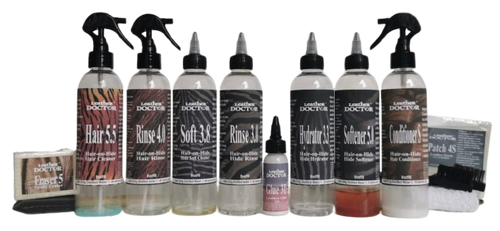Hair-on Hide Zebra and Cow Sofa Cleaner, Conditioner, and Repair Kit H6 by Leather Doctor cleans and conditions the hair with repairs and conditions the hide.
Kit H6 is designed to clean, condition, and repair hair-on-hide upholstery, ensuring both the hair and hide are preserved for long-lasting durability. A hair-on hide refers to the complete, unaltered skin of an animal, such as a zebra or cow, with the hair intact. The reverse side of the hide is tanned to create a suede-like texture, making it a popular choice for rugs, ottomans, armchairs, and sofas.
Why Regular Maintenance is Essential?
Over time, the natural oils and fats within the hide that maintain its suppleness gradually evaporate. This loss, caused by the depletion of volatile organic compounds (VOCs), reduces the hide's tear strength. Factors such as exposure to direct sunlight, fireplaces, or other heat sources accelerate this drying process, leaving the hide brittle and more prone to damage.
Common Issues and Causes:
* Dry Rot:
Dry rot develops when tanning oils and fats evaporate, often exacerbated by forgotten spills left uncleaned. As the hide dries out, it becomes stiff, fragile, and prone to breaking under pressure. Regular replenishment of fats and oils prevents dry rot, ensuring the hide remains soft, strong, and durable.
* Hair Loss:
As the hide ages and dries, hair follicles weaken and lose grip, leading to bald spots from friction. This is an early indicator of slow dry rot. Conditioning with fat liquors restores oils, improves hair retention, and prevents further damage.
Repairing Tears on Hair-on-Hide
Rips or tears signal a significant loss of tear strength. Before any repair, the hide must be properly cleaned, rinsed, hydrated, and fatliquored to restore its structural integrity. Repairs are conducted directly from the hair side without removing the hide, using the following steps:
1. Hydration and Fatliquoring:
Rehydrate and restore lost oils and fats to regain suppleness and tensile strength.
2. Bonding Adhesive:
Apply a leather bonding adhesive that integrates seamlessly with the hide.
3. Patch Application:
For added strength and aesthetics, a thin top-grain leather patch is applied over the repair area.
Proactive Care and Maintenance
Regular cleaning and conditioning play a crucial role in maintaining hair-on hides. Removing dirt and debris reduces hair breakage, while rub-resistant conditioning prevents wear and improves the hide’s resilience. Fat liquoring replenishes the hide’s oils, preventing bald spots and preserving its practical and aesthetic qualities over time.
Mixing Instructions for Kit H6
Kit H6 products are concentrated and require dilution before use:
- Add 1.071 kg (or 1.17 quarts) of distilled water to the bottles.
- Fill the bottles up to 1.5 inches below the top for proper mixing.
- Follow the provided sequence of steps to ensure a seamless dovetailing process and achieve optimal results.
By following these care and repair guidelines, your hair-on-hide furniture will retain its beauty, softness, and strength, ensuring years of lasting quality.
Instructions:
A water-based, pH 5.5 mild disinfectant cleaner designed to reduce odors during the drying process of hair-on hides. It cleans gently by penetrating the surface, lubricating, and suspending dirt through a chemical reaction for effective, delicate cleaning.
Steps:
- Remove dry soil by vacuuming foreign particles while brushing along the lay of the hair.
- Apply Hair 5.5 and brush along the lay of the hair in one direction. Use a cotton towel to extract suspended soiling until clean. Rinse and repeat as necessary.
A pH 4.0 rinse that complements Hair 5.5, removing suspended soiling while balancing the pH of hair-on hides.
Steps:
- Apply Rinse 4.0 and brush along the lay of the hair in one direction. Use a cotton towel to extract suspended soiling until clean, ensuring a squeaky feel. Proceed to hydration.
A pH 3.3 water-based leather hydrating relaxer used before fatliquoring. It also acts as a surfactant cleaner to remove surface remnants.
Steps:
- Apply Hydrator 3.3 directly onto the base of the hair using a brush or comb. Spray, drip, or transfer to a foam brush for controlled application.
- Saturate the entire panel evenly, ensuring no dry edges. Moisture should ooze slightly when pressed with fingers.
- Massage, flex, and stretch the repair area to overlap rips or tears.
- When the hide is damp (approximately 25% moisture content as measured with a leather moisture meter), proceed with Fatliquoring.
A pH 5.0 ionic negatively charged micro-emulsion of fat, oil, and water, designed to soften hides and enhance tensile strength.
Steps:
- Apply Fatliquor 5.0 as with Hydrator 3.3.
- Saturate until slight moisture oozes out when pressed.
- Allow natural evaporation, leaving essential fat and oil behind.
- Repeat if needed, based on dryness, until no more is absorbed.
- Use a leather moisture meter to confirm fat and oil content (aim for ~14%).
- Rinse any sticky residue with Hydrator 3.3 to reduce soiling or enhance appearance.
- Spray Hydrator 3.3, brush, and wipe with a cotton towel until clean.
- Allow slow natural drying for increased suppleness.
- Stretch and close rip or tear locations tightly during the drying process.
A water-based, medium-soft leather adhesive for repairing tears, rips, and scratches.
Steps:
- Prepare repairs by cutting a paper template with a centerline for precise positioning before glue bonding.
A smooth full-grain lambskin patch with suede backing, only 0.4mm thick, designed for seamless tear repairs.
Steps:
- Insert Patch 4S into position, ready for glue bonding.
A nonstick, rub-resistant conditioner that provides a smooth finish to shield the detrimental effects of sticky soiling for all hair-on hide.
Steps:
- Mist S evenly over the hair and brush along the lay of the hair.
- Once dry, groom again with a brush or comb for optimal appearance.
Your opinions and insights are precious and will help us solve your leather problem more efficiently.
Edited January 23, 2025 by Roger Koh.

















